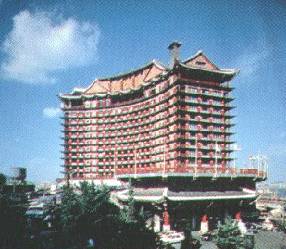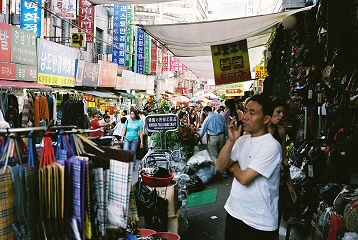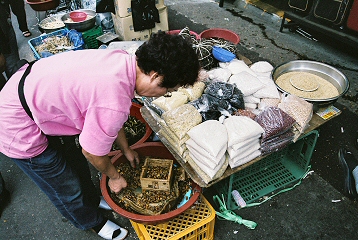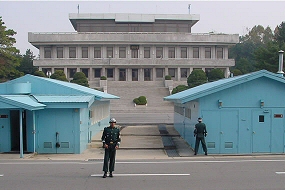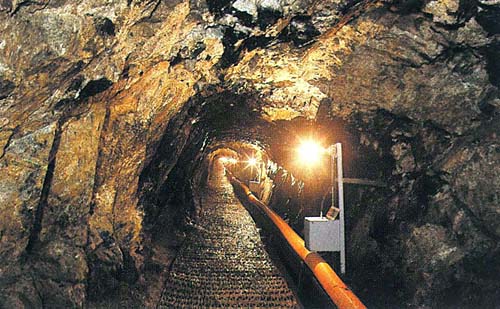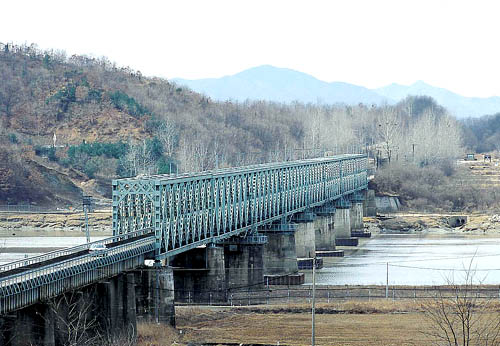 |
South Korea Journal September 2004
|
I arrived at the
International Ferry Terminal in Osaka too early to board The PanStar Dream,
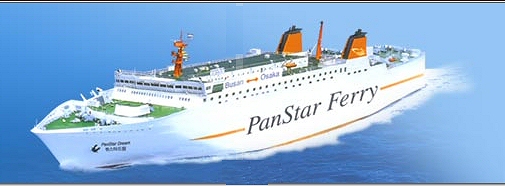 my 4:00 PM ship to Pusan (a/k/a Busan) on the southern coast of South
Korea. I had reserved a 2-person room and lucked out when they did not sell
the other bed, leaving me all alone for the 18-hour passage. There are
about 100 passengers, and probably as many containers, on-board. Trucks had
spent the two hours prior to our boarding loading the lower two floors of
the ship with large containers of freight – I think we are mainly a
freighter with the capability to carry passengers. I would guess that about
80% of the passengers are Korean, 19% Japanese and 1% Western (me). The
crew is Korean. my 4:00 PM ship to Pusan (a/k/a Busan) on the southern coast of South
Korea. I had reserved a 2-person room and lucked out when they did not sell
the other bed, leaving me all alone for the 18-hour passage. There are
about 100 passengers, and probably as many containers, on-board. Trucks had
spent the two hours prior to our boarding loading the lower two floors of
the ship with large containers of freight – I think we are mainly a
freighter with the capability to carry passengers. I would guess that about
80% of the passengers are Korean, 19% Japanese and 1% Western (me). The
crew is Korean.We sailed at exactly 4:00 PM. I wandered around the ship for a while, checking out the top deck and the restaurant, but I could not communicate with anyone and there were no signs in English so I decided to return to my room and read my Korean guidebook until dinner. I had spent all but 2000 yen, which, I hoped, would buy me dinner and breakfast aboard ship. I went to dinner at 6:30 PM and found the menu was in Korean. When I asked the waitress to help translate the menu, she turned it over to show me the Japanese version. I wasn’t really hungry, but had to dispose of half my 2000 yen so without having any idea what I was doing I ordered the only thing on the menu that was less than 1000 yen – Bibimbap. As I sat waiting for my mystery dinner, I remembered that the Koreans ate whale meat and although I had tasted this in Norway a couple years ago, I hoped I would not have to eat a whole plate of the stuff. My wait continued and I noticed that I was attracting a lot of attention in this restaurant, being the only Westerner. Then I remembered that the Koreans also ate dog meat and I was sure that the Korean word for dog meat started with a ‘B’. When the meal finally came, I quickly determined that it was not whale meat. The large bowl of rice was covered with an egg, unfamiliar vegetables and a healthy spoonful of brown meat in one corner which I convinced myself must have been recently been covered with fur. As everyone in the restaurant stared at me, I was proud of the way I manipulated my chopsticks delicately eating the egg, vegetables and rice but totally avoiding the brown stuff. About halfway through the meal, the waitress came over and tried to explain something to me but I could not understand. She pointed to several people in the room and then reached for my chopsticks, which I handed to her. Apparently some of the other customers had pointed out that I was not eating my Bibimbap correctly and she proceeded, much to my horror, to mix the remaining food in my bowl so it would be ‘more delicious’, the only two English words I understood. Now with everyone smiling and nodding she handed the chopsticks back so I could finish my dinner. There was no way that I couldn’t finish the bowl that now had the meat mixed-in with everyone staring at me. But I didn’t linger too long after paying my bill and rushed to the little gift shop on board and bought some bottled water and shrimp chips (look like French-fries, taste like potato chips but are made from ground shrimp) using my breakfast money and went back to my room to brush my teeth. As it turned out, the Korean word for dog meat is Bosintang (actually dog meat soup). The meat I had eaten was beef. Page 52 of my Korean guidebook specifically states that when you order Bibimbap (apparently as popular in Korea as sushi in Japan) the first thing you must do is mix it all together. I had only read as far as page 48 when I went to dinner. The rest of the trip was smooth. The TV in my room had more English language movies than anyplace I’ve been in the last two months. I went up on deck Sunday morning to watch us arrive at the Port of Pusan. The port reminds me of Hong Kong with large apartment buildings perched on steep mountainsides with a busy seaport. As we entered the harbor two huge cranes carrying a vast section of a hull for a new ocean tanker, were being pushed by several tugboats to a dry dock where the massive shop was being fabricated. Pusan is the fourth busiest container port in the world.
Monday I ate breakfast at
the hotel and then set off on a walking tour of Nampo-dung, the section of
Busan where my hotel is located. I walked down the hill an immediately
entered Gukje Market, a large area where the shops overflow onto the
sidewalks and everything under the sun is sold. I walked through the market
to the waterfront where I visited the Shin Dong-A Fish Market, The Jaga lchi
Fish Market and the Dry Seafood Wholesale Market. I had to take frequent
short breaks to breath normal air as the odor of seafood laid-out in 90
degree heat was almost unbearable.
To get out of the heat, I
headed underground and explored the shops which line the corridors which
parallel the subway system. I emerged from the subway near the International
Ferry Terminal and found a staircase with 150 steps which led back to my hotel.
I watched a movie in the late
afternoon, made arrangements to fly to Jeju Island tomorrow and had a late
dinner at the hotel. I've decided that I will try to climb the highest mountain
in every country I visit. South Korea's highest mountain in Mt. Halla, an
extinct volcano on Jeju Island - Korea's Hawaii. It is only 1950 meters high
but will make a good day-hike.
I thought I could squeeze in
another bus tour of the Haeundae section of Busan Tuesday morning before I left
for the airport. Haeundae is a very modern part of Busan with large office
towers, modern hotels and a new convention center. We crossed the Gwangan Grand
Bridge, Korea's longest at over 7KM, and visited Haeundae Beach where large
waves were breaking on the white sand. We also went to the UN Cemetery where
2300 of the 35,000 UN troops killed during the Korean War are buried, and then
went to the Busan Museum before heading back to Busan Station. I took a cab
back to my hotel where I checked-out and caught the 11:55 AM bus to the airport.
My flight to Jeju was not until
2:40 PM but it left on-time and arrived less than an hour later. It was a
10-minute taxi ride to the Jeju Crown Plaza where I checked-in and then spent a
couple of hours exploring the hotel and casino before dinner. My room has a PC,
but they charge $15/day for its use.
Wednesday morning I spent a
half-hour talking with the concierge trying to determine when and how to climb
Mt. Halla. There are four routes, but only two of them go to the summit. Of
these, Seongpanak Trail is served by the public bus system while Gwaneumsa Trail
is not. I decided I would take the bus up to the Seongpanak Trailhead to check
it out and gather any additional information. It took about an hour and the
trailhead was easily recognizable by the thirty large busses parked it the lot.
Although it was raining, several hundred high-school students were assembled in
the lot getting ready to climb. I am glad I have allowed as much as a week here
on Jeju so I can wait for a nice day to climb. There was a photo exhibit in the
trailhead office with beautiful pictures of the mountain and
Lake Baengnokdam,
the lake in the crater at the summit. After getting as much information as
possible, I took the bus back to town.
My friend the concierge told me
he thinks it is going to rain again tomorrow. I decided to check the weather
myself on the Internet. To my dismay, the five-day forecast called for rain and
thunder every single day! If I was going to get wet, I might as well do my hike
tomorrow. I went to the local supermarket to buy some dinner and some food for
my climb.
Thursday I was up at 4:00 AM.
I checked the forecast again and it had not changed, but it had not started
raining yet so I packed my stuff and took a taxi to the Gwaneumsa Trail-head
which I would climb and then descend the Seongpanak Trail where I could take the
bus back to town. I arrived at the trail-head at 5:50 AM, but had to spend the
first ten minutes arguing with someone who clearly worked there, but was not
senior enough to have a key to get into the office. I think he was trying to
tell me that the trail was one-way and I had to start up Seongpanak and descend
Gwaneumsa. This was contrary to what I had learned yesterday and also
interfered with my plan to return to the city by bus, but after a while he let
me go.
One of the interesting features
of this trail is Gurin
Volcanic
Cave.
I had thought it was a lava tube which the trail actually went through for a
distance, but at no time did I ever enter a tunnel so I missed the actual cave.
The trail to the summit is 8.7KM and took just short of four hours to complete.
The rain held off until about 8:30 AM, but then the sky opened up and it poured
for the duration of the hike. I did not meet any other hikers until I was about
20 minutes from the summit. When I arrived at the top, it was completely
enshrouded in clouds and I could not even see the lake, which I estimated, was
less than 100 meters away.
I started down the Seongpanak
Trail after just a few minutes. After only a couple hundred meters, I met
hundreds of South Korean soldiers coming up. I moved to one side to let them
pass, but they just kept on coming so I decided I should try to go down. The
soldiers were followed by hundreds of high school students. I began to think
that this trail should be one-way and then realized that it probably was.
There was quite a bit of
thunder on the way down, but I saw no lightening. The trail down is 9.7KM and I
reached the bottom at 1:30 PM, a 7 1/2 hour day. After a cup of coffee at the
restaurant, I took the bus back to town where I got a cab to my hotel.
I showered and spent a couple
hours writing and planning my next week. There are a couple of more things I
would like to do here on Jeju before going to Seoul, but the constant rain may
interfere with my plans. For dinner, I went to The Oriental Hotel, not the same
standard as Hong Kong, but nice nonetheless. I ate at a table facing the water
where a large double rainbow had formed.
Friday, September 17th, I had
decided to visit 13,422 meter long Manjang Cave, the longest in the world. I
was sure this would be a good rainy-day activity, but when I talked to the
concierge to arrange a private car, I learned that the cave was closed because
the heavy rains had made the roof of the cave unstable and it is too dangerous
to walk through.
I walked over to The Grand
Hotel which is said to be the nicest hotel on the island. I had dinner on the
top floor which normally overlooks the ocean, but tonight was covered in
clouds. After dinner I spent the evening at the Grands Casino.
Saturday morning I ate
breakfast and saw that the lobby was packed with Japanese men leaving to play
golf. The fact that it was pouring rain didn't seem to faze them. The forecast
continues to be for more and more rain so I hope they have not come here for the
whole week to play golf. I read an interesting article in the paper this
morning at breakfast. Three taxi-drivers are being sued by their employer for
cooking and then consuming the owner's pet dog.
I checked-out of The Crown
Plaza and took a taxi to the airport for my 11:50 AM flight to Seoul. The
flight left on time and I was pleased to see that it was not raining in Seoul.
I took a taxi to The Holiday Inn in the Mapo Section of Seoul which seems to be
a good location near a subway station. I noticed a Dominos Pizza near the hotel
and went there for dinner.
Sunday
I took a 2-hour bus tour of downtown Seoul. It was a beautiful day and the
tour really served to orient me. There
are several areas which I plan to go
back to in the next few days. In the afternoon, I arranged a tour of Changdeokgang Royal Palace. On this tour, there were four women from
Jakarta, one guy from Iran and myself. In addition to the
palace tour, we
also went to the Namdaemun Open Air Market
Monday
morning I traveled one hour by subway out to pick-up a Suunto watchband I had
special ordered. The place was difficult to find, but when I got there, the
manager installed the band for me. I had been trying to find a band to fit this
watch for months, but I had never been in one place long enough to place the
order and still be able to receive it. It rained during my trip and I think I
caught a cold. I took the subway back but instead of getting off at Mapo
where my hotel was located,
Tuesday, I went on a
tour of the Demilitarized Zone between South and North Korea. I was
picked-up at 8:00 AM at my hotel and joined a group which continued north
for about an hour. When we reached the northern most part of South Korea,
the rivers are lined with barbed wire with guard stations every 100 meters
to discourage North Koreans from floating down the river in an attempt to
get to the South. Another interesting feature along the smaller roads are
the signs every five meters warning people not to enter the mine-fields
which exist throughout the region.
The most fascinating
part of the tour was our descent into the Third Invasion Tunnel.
Discovered in 1978, this is one of four known tunnels dug by the North Koreans
under the DMZ into South Korea for the alleged purpose of invading the South.
The tunnel is large enough for small vehicles and are up to 100 meters below
ground level. We descended a 400 meter decline to intersect with the
actual tunnel and were able to walk another 400 meters to the edge of where the
DMZ exists above ground.
Here
the tunnel has been blocked-off.
From
Dora, we went to
Imjingak
Park
where I took a picture of Freedom Bridge. Our last stop was Dorasan
Station, the northern most train station in South Korea, built with private
donations of South Koreans with relatives in the North who one-day hope to
reunite the Koreas. It
rained again on the way back to
Seoul.
I had not been feeling well all day and when we stopped at a tourist market
to buy souvenirs, I decide to take a taxi back to my hotel and go to bed
early. I spent my last couple days in Korea in bed with what by now had become the flu. I felt awful, but decided I would rather feel awful in China so I took a flight to Beijing. I was concerned about getting through the health check at immigration, but through an amazing stroke of luck, my international arrival was mistakenly routed through the domestic terminal. When the error was discovered, there was quite a bit of shouting amongst immigration officials and I am sure some people will be lucky if they only got fired, but the net result was that we were herded back through immigration and customs, but avoided the health check. |
|
